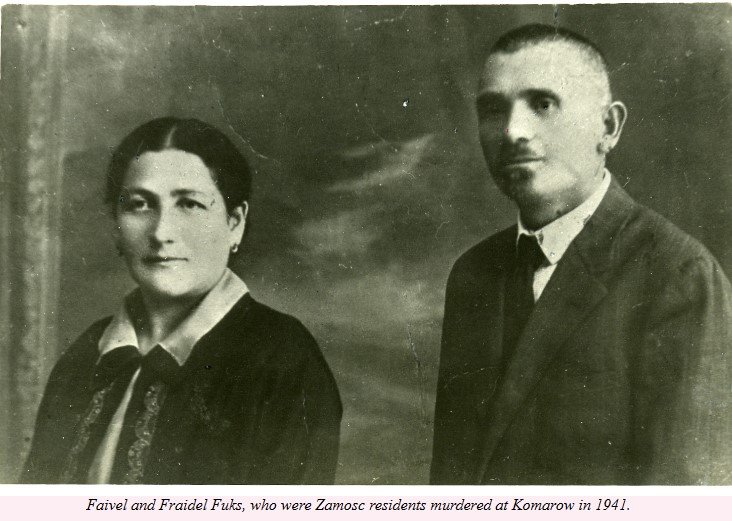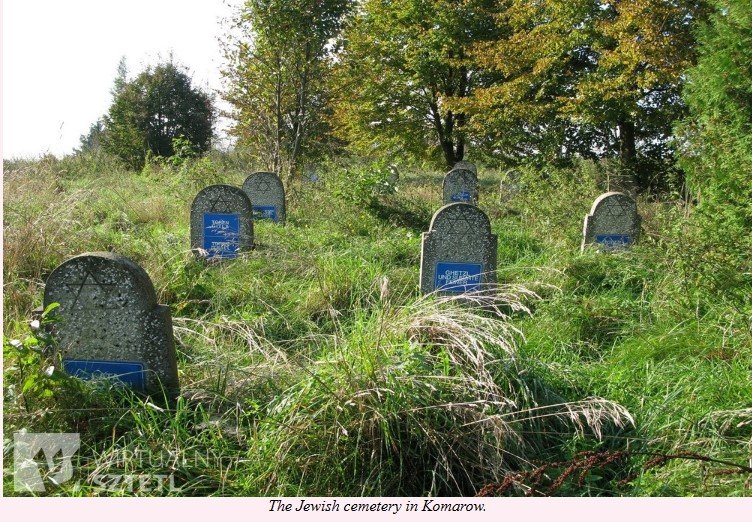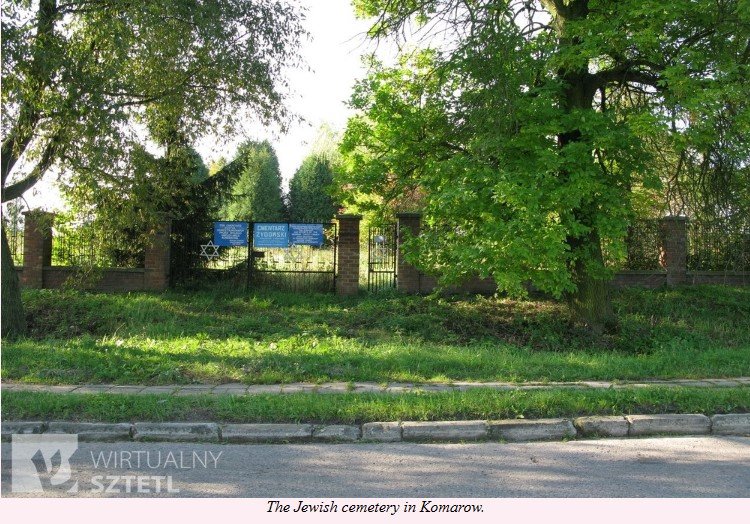Remember Jewish Komarów (Osada)
Pronunciation: Komm-are-ov
JEWISH HISTORY
It is unclear when the Jewish community of Komarow was established, but by 1750 Jews in town had established a synagogue, prayer house and cemetery. In 1766, 247 Jews lived there. In 1856, the town had a total of 1,625 residents, including 943 (58%) Jews. In 1897 there were 2,618 people living in the town and Jews constituted 59% (1,568) of the total population. In 1921, 60% of the 1,752 residents were Jews. Supporters of a tzaddik from Kock had established their shtibl in Komarow around 1850. Before the war, there were about 1,752 Jewish inhabitants out of 2,895 total. The town rabbi was Szyja Alterman. Ritual slaughterers in town were: S. M. Bobek, F. Becher, and M. Elster.
DURING THE HOLOCAUST
Komarow was occupied by the German forces on September 13, 1939 . Russian forces marched into the town on the 28th of September 1939, but they withdrew after 12 days, giving way to the German occupiers. Part of the Jewish community left Komarow during the retreat of the Russians. The Nazis began to victimize the Jewish community shortly after they arrived and set appointed a head of local administration and created the Polish auxiliary police. In late 1939, a Jewish Council was established, and a Jewish police force was formed. Daniel Szwarc and Leibel Fruchtkaufer were the chairman and vice-chairman of the Judenrat. Abram Elbaum was also chair of the Judenrat at one point and also ran a self-help organization. In July 1941, Kelman Fogiel assumed the JSS (Jewish Self-Help) chairmanship. During the war, an illegal yeshiva operated in the town with around 40 students, operated by Rabbi Alterman.
In command of the Komarow ghetto was the S.S. man, sadist Ernst Schultz. Other S.S. men in Komarow included Helmuth Weihenmaier, Heinrich Schoenemann (Schonemann) and Ferdinand Schwabe. After the Nazis ordered all Jews to wear an armband with the star of David, around 30 Jewish disobedients were caught by Nazi soldiers and taken to the local cemetery, where they were executed. Slave labor was one of the main tasks of the Jews in the Komarow ghetto. There was an extensive network of labor camps in the area:
** From the spring until late October 1940, 350 men from Komarow were interned at labor camps such as Narol (south of Tomaszow Lubelskie) as well as a water drainage camp at Bortatycze.
** Feldman, an ethnic German collaborator with the Germans, employed Jewish craftsmen at the tannery in Komarow.
** Other Jewish laborers worked on the Komarow to Zamosc road construction project, which was completed before the German invasion of the Soviet Union in June 1941.
** In April of 1941 a group of 400 Jews from Komarow ghetto were sent to the Zamosc ghetto. Separate from this, some 1,000 Jews traveled daily to work sites near and in Zamosc; for example, some worked at a sawmill, while others were in slave labor at two Czech construction firms. The Czech firms had received contracts by the Bauleitung der Luftwaffe and were constructing bases at Labunie and Mokre.
** Jews in the Komarow ghetto were also sent to the Tyszowce Labor Camp between spring 1941 and fall of 1942.
** There was also a nearby labor camp in Rachanie that Komarow ghetto residents were sent to between April of 1942 and Aug of 1943.
** Many Jews from Komarow and Zamosc subsequently worked at the Luftwaffe airfield bases either interned there, or in Zamosc itself.
** In the spring of 1941, children residing in Komarow went to work for Polish and Ukrainian villagers as domestic servants or farm laborers during the week. They returned home on Saturdays, usually bearing food their employers provided to supplement the wages they paid to the Arbeitsamt Labor Office.
** Other locations where Jews were sent included Laszczow Labor Camp and the airport at Labunie.
** Finally, Jews in Komarow were sent to the Mikulin Labor Camp between May and November of 1942.
A ghetto was created in Komarow in the summer of 1941, although there was no wall surrounding it initially. Jewish police, under Nazi rule, patrolled it. In September 1941 there were 3,000 Jews in the ghetto. Included in this group were: 730 Jews from Prague and Vienna who had arrived in May 1941; 200 Jews from Wloclawek, Kolo and Czestochowa who had arrived in 1940; an unknown number of Jews from Lodz and Sierpc; 400 Jews from Zamosc; and an unknown number of Jews from Krasnobrod, Laczczow, and Tyszowce.
In the spring of 1941, Ernst Schulz shot and killed, 19-year-old Mordechai Motel Tempkin. In November 1941, Hans Frank, the Governor, imposed the death penalty on the Jews in the Generalgouvernement found without permission outside of their places of registration. Typhus epidemics broke out in the ghetto in May of 1941, again in September of 1941, and again in January of 1942.
Gendarmes, led by Nazi S.S. man Ernst Schulz, rounded up members of the Judenrat and Jews without work permits and executed them in June 1942. On July 5, 1942, Kielman Fogiel informed the JSS officials that the Komarow ghetto had 1,723 inmates, including 650 Jews from Czechoslovakia. The Jewish ghetto residents also sustained beatings, especially from Schulz, and on October 5, 1942, he ordered approximately 50 young men and women to the square for municipal cleaning duties. They were surrounded by the S.S. and killed. Additionally, in the autumn of 1942, in the village of Zwiartów, Krynica commune, Jan Chmiel participated in the murder of five Jews hiding in the forest.
Several deportations took place from Komarow, including two in May of 1942 that included over 2,000 Jews. One of these transports went to Belzec Death Camp and the other went to Sobibor Death Camp. In November, 1942, 1,000 additional Jews were sent to Belzec. The Nazis also murdered approximately 2,500 Jews situated in Komarow ghetto between 1st October and 31st of October 1942. Bodies of the dead Jews were buried in a field in several mass graves. The ghetto was liquidated in November 1942.
Fewer than 15 Jews from the town survived the war.
Please review the site content below. Zachor - We Remember.
------------------------------------------------------------------------
[Jewish Partisans in Poland's Lublin District]
[Komarow — Jewish cemetery]
[Komarow-Osada: Report from Yahad in Unum]
[Testimony of survivor Adam Shtibel]
------------------------------------------------------------------------
Facebook group for Komarow Jewish researchers!
Return to Lublin IndexLINKS
Join the Komarow group on Facebook!
Holocaust Survivors of Komarow:
- Hanoch Ehrlich
- Dora Fields
- Mincia Fogel (repatriated to Gluszyca)
- Emil Goldbarten
- Mordechai Mendelovich
- Simeon Menyuk
- Adam Shtibel (Sztibel)
- Abisz Szwarcz
- Lejzor Weiss
- Tzvi Zohar
Rabbis of Komarow:
- Szyja Yehoshua Alterman
- Dawid Engelsberg
- Yechiel Engelsberg
- Chaskiel Gaut
- Yitzchak Szulewicz
Notable People:
- Moshe Yechiel Epstein
- Rabbi Yitzchok Hendel
- Rabbi Solomon ben Judah Kluger
Genealogy:
- Jewish Records Indexing Poland - Komarow
- Jewish Vital Records in the Polish State Archives
Remember Your Family:
- Central Judaica Database - Museum of History of Polish Jews
- Grandchildren of Holocaust Survivors on Facebook
- Guide to the YIVO Archives
- Holocaust News/Events from Generations of the Shoah Int'l
- Holocaust Survivors and Victims Database
- JewishGen Family Finder
- JewishGen Holocaust Database
- JRI-Poland: Search for Your Family
- Museum of History of Polish Jews Introduction
- Yad Vashem: Search for Your Family
- Yad Vashem: Submit Names of Your Family Members
- Yad Vashem Requests Photos of Shoah Survivors and Families
CONTACTS
U.S.: LublinJewish@gmail.com







